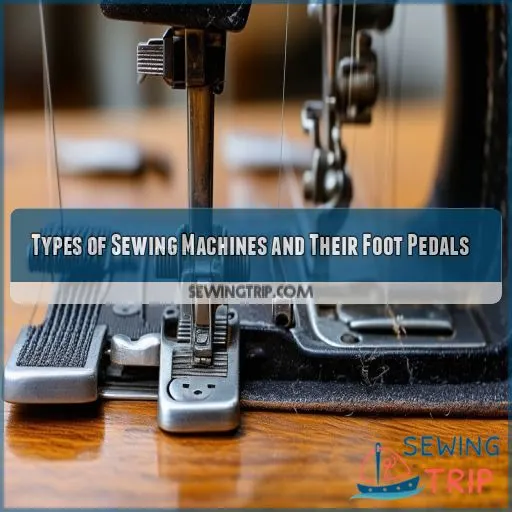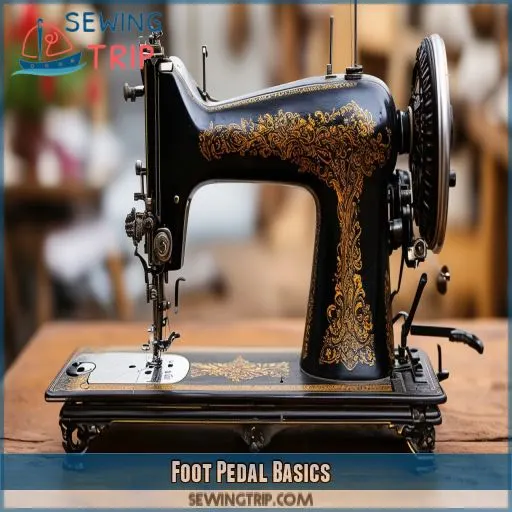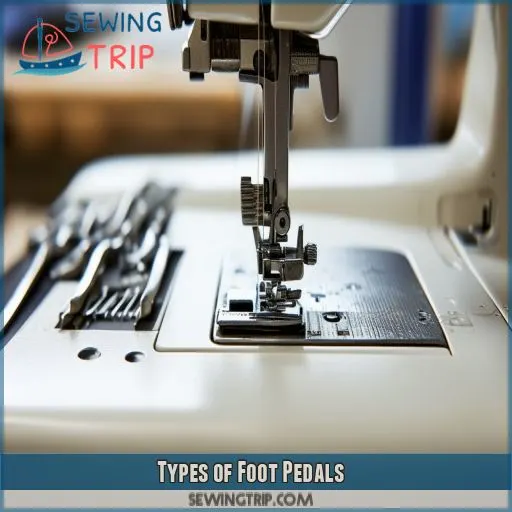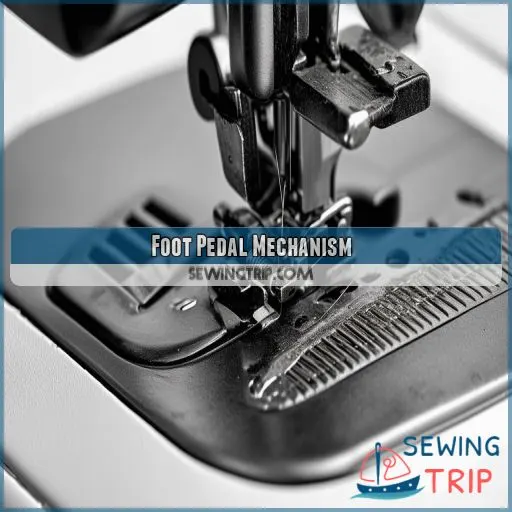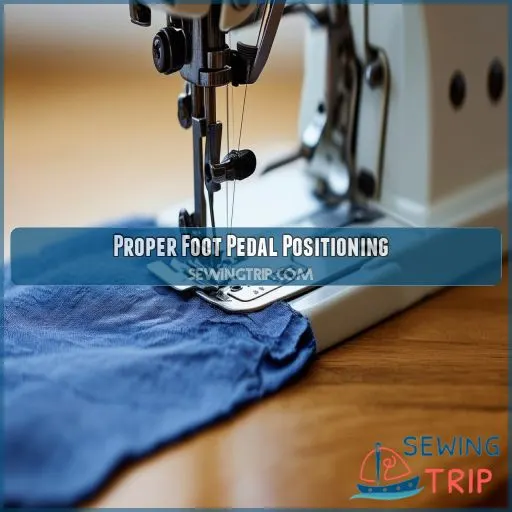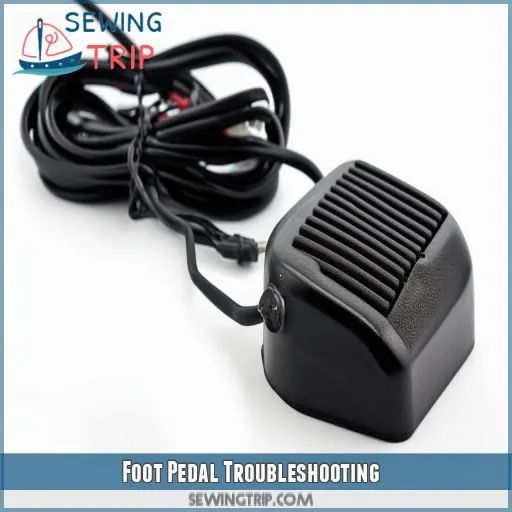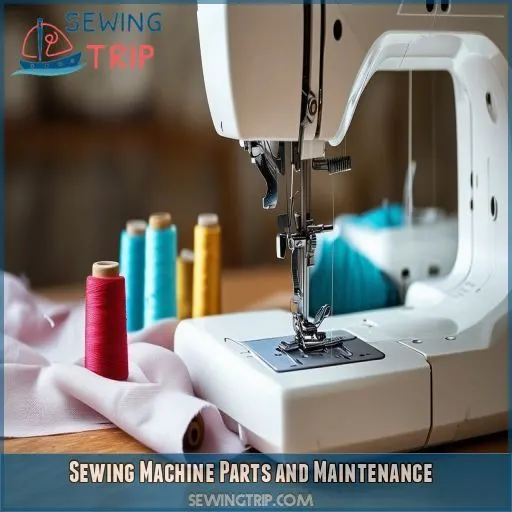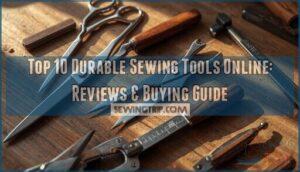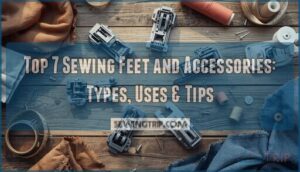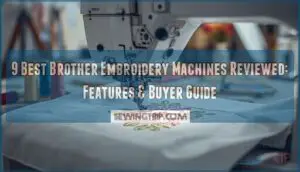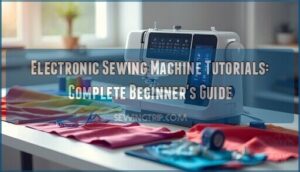This site is supported by our readers. We may earn a commission, at no cost to you, if you purchase through links.
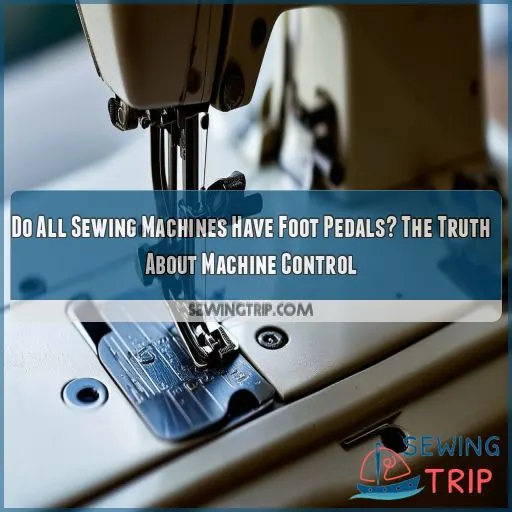 No, not all sewing machines have foot pedals. While traditional mechanical machines rely on foot pedals for speed control, modern computerized models often feature alternative options.
No, not all sewing machines have foot pedals. While traditional mechanical machines rely on foot pedals for speed control, modern computerized models often feature alternative options.
You’ll find start/stop buttons and speed sliders on many contemporary machines, allowing for hands-free operation. However, foot pedals remain a popular choice for their precision and ease of use. Some machines offer both pedal and button controls, giving you the flexibility to choose your preferred method.
Whether you’re a seasoned seamstress or a beginner, understanding your machine’s control options is important for achieving the best results. Let’s explore the various types of sewing machines and their control mechanisms in more detail.
Table Of Contents
Key Takeaways
- Not all sewing machines are created equal when it comes to foot pedals. While many traditional models rely on these trusty speed controllers, modern computerized machines often march to the beat of a different drum with start/stop buttons and speed sliders.
- Foot pedals aren’t just one-trick ponies. From mechanical workhorses to computerized wonders, different machines sport various types of pedals. It’s like choosing between a sports car and a luxury sedan – each has its own unique feel and features.
- Don’t let a missing foot pedal put a wrench in your sewing plans. Many machines offer alternative control methods, so you can still stitch up a storm even if you’re not keen on fancy footwork.
- Proper pedal positioning is the secret sauce for sewing success. Finding your sweet spot can mean the difference between a comfortable quilting marathon and feeling like you’ve run an actual marathon with your feet.
Do All Sewing Machines Have Foot Pedals?
No, not all sewing machines have foot pedals. While most modern sewing machines use foot pedals for speed control, some older treadle machines use a foot-powered mechanism, and certain computerized models offer alternative control options like push-button or touchscreen interfaces.
Types of Sewing Machines and Their Foot Pedals
You’ll find that sewing machines come in various types, including mechanical, computerized, and treadle models. While most modern machines use foot pedals for speed control, some newer computerized models offer alternative control methods like start/stop buttons or knee lifters.
Mechanical Sewing Machines
Mechanical sewing machines are the workhorses of the sewing world. You’ll find they rely heavily on foot pedals for speed control. These machines offer:
- Direct needle control through pedal pressure
- Manual tension settings for precise stitching
- Bobbin winding with foot pedal assistance
- Versatile fabric compatibility
You’ll need to master the foot pedal’s nuances to achieve satisfactory results. Regular oiling keeps your mechanical marvel running smoothly, ensuring you’re always in control of your creative process.
Computerized Sewing Machines
computerized sewing machines take control to the next level. While they often include foot pedals, they offer alternative ways to manage your sewing speed:
- Start/stop buttons for pedal-free operation
- Speed slider controls for precise adjustments
- Programmable stitch sequences
- Automatic thread tension regulation
- Touch screen interfaces for easy feature access
These advanced features give you more options to tailor your sewing experience, whether you prefer traditional foot pedal control or want to explore new ways to manage your machine’s speed and functionality.
Treadle Sewing Machines
Treadle sewing machines are the original foot-controlled powerhouses of the sewing world. Unlike modern electric machines, they rely on your leg power to operate. Here’s what makes treadle machines unique:
- Mechanical marvel: A large wheel connected to a foot-operated treadle
- Rhythmic motion: Your feet rock the treadle, spinning the wheel and powering the needle
- Vintage charm: Often housed in beautiful wooden cabinets, blending function with furniture
These machines offer a direct connection to sewing history, providing a tactile, hands-on experience you won’t find with modern start/stop features.
Foot Pedal Basics
Foot pedals are the unsung heroes of your sewing machine, giving you precision control over your stitching speed. They’re not just a simple on/off switch; they’re your direct line to the machine’s motor. When you press down, you’re increasing the current flow, which in turn ramps up the needle speed. It’s like having a gas pedal for your creativity!
Here are three key things to remember about foot pedals:
- They’re connected to your machine via a power cord.
- The harder you press, the faster your needle will move.
- They help improve your hand-foot-eye coordination.
Mastering your foot pedal usage is crucial for achieving consistent stitches. Regular foot pedal care, including checking the cord for wear, ensures optimal performance. If you’re experiencing issues, consider foot pedal replacement or checking compatibility with your machine model. Remember, the right foot resistance can make all the difference in your sewing experience.
Types of Foot Pedals
Now that you comprehend the fundamentals, let’s delve into the diverse types of foot pedals you may encounter on your sewing odyssey. Foot pedals aren’t uniform; they vary in form and dimension to accommodate various machines and user preferences. Here are the primary types you’ll encounter:
- Universal foot pedals: Compatible with multiple machine brands
- Machine-specific foot pedals: Designed for particular models
- Knee pedals: Operated by knee pressure, freeing hands
- Traveling foot pedals: Portable options for mobile sewists
Each type provides unique advantages concerning pedal functionality and ergonomics. Universal pedals offer versatility, while customized pedals guarantee exceptional performance for specific machines. Ergonomic pedals minimize fatigue during extended sewing sessions, and adjustable sensitivity enables you to refine your control. Regular foot pedal maintenance is essential for seamless operation and longevity. By understanding these options, you’ll be better equipped to select the appropriate pedal for your needs and maintain command over your sewing projects.
Foot Pedal Mechanism
Now that we’ve explored the types of foot pedals, let’s investigate how they actually work. The foot pedal mechanism is a marvel of engineering that gives you precise control over your sewing machine’s speed. Here’s what’s happening under the hood:
- Variable resistance: As you press down, the pedal’s internal resistor changes, allowing more current to flow.
- Spring action: A built-in spring returns the pedal to its original position when you release pressure.
- Electrical wizardry: The pedal’s wiring connects to your machine, translating your foot’s movement into speed control.
This clever design lets you effortlessly adjust your stitching pace. Whether you’re working on a delicate silk blouse or powering through denim on your Husqvarna Viking Opal 690Q, the foot pedal responds to your every move. It’s like having cruise control for your sewing projects! If you’re experiencing issues, electrical troubleshooting might be necessary to guarantee smooth operation.
Proper Foot Pedal Positioning
Proper foot pedal positioning is essential for comfortable and efficient sewing. You’ll want to place your foot pedal where it feels natural, without straining your leg or lifting your heel excessively. Use whichever foot feels most comfortable – right or left – and position the ball of your foot on the pedal with your heel resting on the ground. This setup provides ideal control and reduces fatigue during long sewing sessions.
To guarantee your foot pedal stays put, especially on slippery surfaces like laminate floors, consider using a non-slip shelf liner underneath. Adjust the pedal angle slightly if needed to match your foot’s natural position.
Here are three key benefits of proper foot pedal positioning:
- Increased comfort during extended sewing projects
- Improved precision and control over machine speed
- Reduced risk of foot and leg fatigue
Foot Pedal Troubleshooting
- Check the connection: Make certain the pedal is securely plugged into your machine.
- Inspect for damage: Look for frayed wires or cracks in the pedal’s casing.
- Test the pedal: Try it on another machine to determine the problem.
- Clean the contacts: Use a cotton swab with rubbing alcohol to remove debris.
If these steps don’t work, it’s time to think about foot pedal repairs or upgrades. Some pedals can be fixed with parts from a hardware store, while others may need professional attention. Remember, foot pedal compatibility is essential – always use the correct pedal for your machine.
Foot pedal ergonomics play a critical role in comfort and control. If you’re experiencing discomfort, try adjusting your seating position or exploring ergonomic foot pedal options. Regular foot pedal maintenance can prevent issues and extend its lifespan.
Sewing Machine Parts and Maintenance
Understanding your sewing machine’s parts and maintenance is essential for smooth operation and longevity. Key components include the needle, presser foot, bobbin, bobbin case, feed dogs, stitch selector, tension dial, and foot pedal. Regular maintenance guarantees excellent performance for all your sewing projects, from machine applique to free motion quilting.
Here’s a quick guide to keep your machine in top shape:
- Clean: Remove lint and debris after each use.
- Oil: Lubricate moving parts regularly to prevent wear.
- Check tension: Adjust as needed for different fabrics and techniques.
- Replace worn parts: Don’t let a dull needle ruin your decorative stitching.
Remember to use the proper foot for each task, whether you’re using an overlock machine or doing intricate work. By mastering these maintenance skills, you’ll have greater control over your sewing outcomes and the freedom to tackle any project with confidence.
Frequently Asked Questions (FAQs)
How to use a sewing machine without a foot pedal?
You can use a sewing machine without a foot pedal by utilizing start/stop buttons, push-button operation, or knee pedals. Some models offer these alternatives. If you’re feeling adventurous, try hand-cranking a vintage machine for a unique sewing experience.
What is the alternative to the foot pedal on a sewing machine?
Where there’s a will, there’s a way. You’ve got options: start/stop buttons on modern machines, knee pedals on some models, or hand cranks on vintage ones. Some computerized machines even offer push-button speed control for precise stitching.
Do all sewing machines have a walking foot?
No, not all sewing machines have a walking foot. It’s an optional attachment you can buy separately. You’ll find it useful for quilting, sewing thick fabrics, or matching patterns. Your machine’s standard foot works for most projects.
Where is the foot pedal on a sewing machine?
You’ll typically find the foot pedal on the floor, connected to your sewing machine by a cord. It’s usually positioned beneath the table, near your feet. Simply place it where you can comfortably control it while sewing.
Does a sewing machine have a foot pedal?
Most sewing machines have foot pedals, but not all. You’ll find alternatives like start/stop buttons, knee lifts, or push-button systems on some models. Your machine’s type and brand determine its control mechanism. Check your specific model for details.
Can you sew without a foot pedal?
Like threading a needle without hands, you can sew without a foot pedal. Many modern machines offer start/stop buttons or knee controls. You’ll find alternatives in computerized models, vintage hand-cranks, and some industrial machines. It’s all about your preferred rhythm.
Can you use a sewing machine without a pedal?
You can use some sewing machines without a pedal. Modern models often have start/stop buttons or knee controls. Vintage hand-crank machines and industrial models with foot switches offer alternatives. Computerized machines may have push-button speed control options.
How does a sewing machine pedal work?
Like a gas pedal in a car, your sewing machine’s foot pedal controls speed. You’ll press down to increase electrical current to the motor, speeding up the needle. It’s a variable resistor that adjusts the machine’s pace.
How do I know if my sewing machine foot pedal is compatible?
Check your machine’s make and model, then compare it to the pedal’s specifications. Look for matching voltage, plug type, and pin configuration. If unsure, consult your machine’s manual or contact the manufacturer for compatibility information.
Can you use a sewing machine foot pedal without a compass?
Sewing machine foot pedals are like compass needles, guiding your stitching journey. You don’t need an actual compass to use one. They’re designed to work with compatible machines, controlling speed and precision as you sew. Just plug in and start creating!
Can foot pedals be used with embroidery machines?
Yes, you can use foot pedals with embroidery machines. They’re not essential, as many models have start/stop buttons, but they offer precise speed control. You’ll find them particularly useful for intricate designs and delicate fabrics.
Are there waterproof foot pedals for outdoor sewing?
You’ll find specially designed foot pedals for outdoor sewing. They’re crafted to resist moisture, ensuring your safety and the machine’s longevity. While not common, these pedals provide peace of mind for open-air stitching enthusiasts. Consider them for worry-free outdoor projects.
How long do sewing machine foot pedals typically last?
You’ll typically get 5-10 years from your sewing machine’s foot pedal with regular use. Proper care and maintenance can extend its lifespan. If you notice inconsistent speed control or unresponsiveness, it’s time to contemplate a replacement.
Can you use a universal foot pedal on antique machines?
Like threading a needle through time, you can often use universal foot pedals on antique machines. However, it’s not always a perfect fit. You’ll need to check compatibility and may require an adapter for older models.
Are there ergonomic foot pedals for people with disabilities?
Yes, there are ergonomic foot pedals designed for people with disabilities. You’ll find options with larger surfaces, adjustable resistance, and alternative positioning. Some even offer hands-free operation through knee or foot movement, enhancing accessibility for various needs.
Conclusion
As the needle rises and falls, so too does our understanding of sewing machine controls evolve.
While not all sewing machines have foot pedals, they remain a popular choice for many sewists. Whether you prefer the traditional foot pedal or modern button controls, the key is finding what works best for you.

